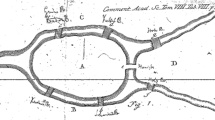Abstract
On the basis of Martin-Löf’s meaning explanations for his type theory a detailed justification is offered of the rule of identity elimination. Brief discussions are thereafter offered of how the univalence axiom fares with respect to these meaning explanations and of some recent work on identity in type theory by Ladyman and Presnell.
Similar content being viewed by others
Notes
The already complicated terminological situation is not helped by the fact that in homotopy type theory, ‘set’ and ‘proposition’ are given novel meanings; see definitions 3.1.1 and 3.3.1 in (The Univalent Foundations Program, 2013).
On the origin of the conjecture, see also Prawitz (2015, p. 45).
Perhaps the first to introduce a special term for what are here called canonical objects was Husserl, who in the second part of his Philosophie der Arithmetik (Husserl 1891, pp. 295–297), speaks of the reduction of problematische Zahlen to Normalzahlen.
The system of Martin-Löf (1975) differs in this respect, since there evaluation works from within.
This introduction rule together with the naturally associated elimination- and equality rules give rise to Curry’s Paradox (Curry 1942).
That an inductively defined predicate cannot occur negatively in the premiss of its own introduction rule is in effect required by the schemes for such definitions given by Martin-Löf (1971, pp. 182–183). The requirement is also made by Dybjer (1994) for his general form of introduction rules in type theory.
This extension of the notion of canonicity can be used to argue that, for instance, \(A\wedge \lnot A\) and \(\bot\) are not equal \(\mathbf {prop}\)s. In the context \(x:A, y: \lnot A\), the term \(\langle x,y\rangle\) is a canonical element of \(A\wedge \lnot A\), but not of \(\bot\).
In the case of \(\Pi\) the higher-order presentation is needed; see Garner (2009, Thm. 4.2’).
That (UIP) is not derivable in Martin-Löf type theory with the \(\text{Id}\)-elimination rule assumed in this paper is a non-trivial meta-mathematical result first proved by Hofmann and Streicher (1998).
References
Boolos G (1971) The iterative conception of set. J Philos 68:215–232
Curry HB (1942) The inconsistency of certain formal logics. J Symb Log 7:115–117
Dybjer P (1994) Inductive families. Form Asp Comput 6:440–465
Garner R (2009) On the strength of dependent products in the type theory of Martin-Löf. Ann Pure Appl Log 160:1–12
Hofmann M, Streicher T (1998) The groupoid interpretation of type theory. In: Sambin G, Smith JM (eds) Twenty-five years of constructive type theory. Oxford University Press, Oxford, pp 83–111
Husserl E (1891) Philosophie der Arithmetik. C.E.M. Pfeffer, Halle
Ladyman J, Presnell S (2015) Identity in homotopy type theory, part I: the justification of path induction. Philos Math 23:386–406
Ladyman J, Presnell S (2016) Does homotopy type theory provide a foundation for mathematics? Br J Philos Sci. doi:10.1093/bjps/axw006
Martin-Löf P (1971) Hauptsatz for the intuitionistic theory of iterated inductive definitions. In Fenstad JE (ed) Proceedings of the second Scandinavian logic symposium, pp 179–216. North-Holland, Amsterdam
Martin-Löf P (1975) An intuitionistic theory of types: predicative part. In: Rose HE, Shepherdson JC (eds) Logic colloquium ‘73. North-Holland, Amsterdam, pp 73–118
Martin-Löf P (1982) Constructive mathematics and computer programming. In: Cohen JL, Łoś J et al (eds) Logic, methodology and philosophy of science VI. North-Holland, Amsterdam, pp 153–175
Martin-Löf P (1984) Intuitionistic type theory. Bibliopolis, Naples
Nordström B, Petersson K, Smith J (1990) Programming in Martin-Löf’s type theory. Oxford University Press, Oxford
Nordström B, Petersson K, Smith JM (2000) Martin-Löf’s type theory. In: Abramsky S, Gabbay D, Maibaum TSE (eds) Handbook of logic in computer science. Logic and algebraic methods, vol 5. Oxford University Press, Oxford, pp 1–37
Prawitz D (1965) Natural deduction. Almqvist & Wiksell, Stockholm
Prawitz D (1971) Ideas and results in proof theory. In Fenstad JE (ed) Proceedings of the second Scandinavian logic symposium, North-Holland, Amsterdam, pp 235–307
Prawitz D (2015) A short scientific autobiography. In: Wansing H (ed) Dag prawitz on proofs and meaning. Outstanding contributions to logic. Springer, Dordrecht, pp 33–64
Shoenfield J (1977) The axioms of set theory. In: Barwise J (ed) Handbook of mathematical logic. North-Holland, Amsterdam, pp 321–344
The Univalent Foundations Program (2013) Homotopy type theory: Univalent foundations of mathematics. Institute for Advanced Study, Princeton. http://homotopytypetheory.org/book
Walsh P (2017) Categorical harmony and path induction. Rev Symb Log 10:301–321
Zermelo E (1930) Über Grenzzahlen und Mengenbereiche. Fundam Math 16:29–47
Acknowledgements
I am grateful to Göran Sundholm for many discussions on the philosophical foundations of type theory and to Per Martin-Löf, who in correspondence clarified what is the canonical form of an element of an Id-set. The comments of two referees at Topoi were of great help when preparing the final version of the paper. Thanks are also due to the referees of a predecessor of this paper that was submitted to another journal. While writing the paper, the author has been supported by Grant No. 17-18344Y from the Czech Science Foundation, GAČR.
Author information
Authors and Affiliations
Corresponding author
Rights and permissions
About this article
Cite this article
Klev, A. The Justification of Identity Elimination in Martin-Löf’s Type Theory. Topoi 38, 577–590 (2019). https://doi.org/10.1007/s11245-017-9509-1
Published:
Issue Date:
DOI: https://doi.org/10.1007/s11245-017-9509-1



